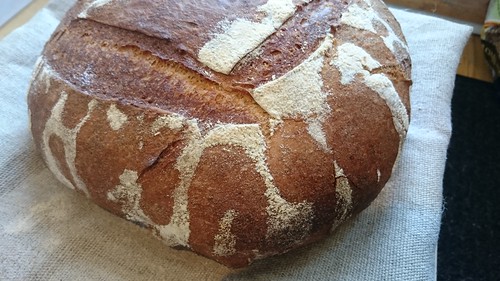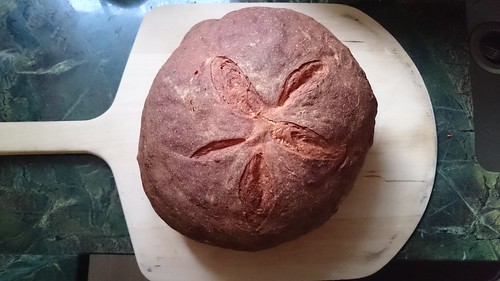Rustic Country Bread (Cook’s Illustrated)
My experiments with high hydration breads at home have been few and far between, but over the past few weeks, I’ve made this rustic bread three times. Each time, I tweaked and refined the Cook’s Illustrated original and the results got successively better.
This recipe
follows what Wikipedia calls the sponge and
dough method.
For my first attempt, I let the sponge ferment for (the minimum)
5 hours, and used the given amounts of flour and water in the final
dough. I didn’t find this dough to be wet at all, and it didn’t need
much flour during final shaping. The extended 15 minute kneading time in
a stand mixer really develops the gluten.
I didn’t have a spray bottle, so I used a squeeze bottle to wet the risen loaf. You can see it made some interesting patterns in the heavy coat of flour.
It took a little longer than 45 minutes for the interior to reach 210°F. The outside colour was very dark, and the interior had a very fine crumb, without any large holes. The crust was quite thick, and the bread somewhat chewy.
For the second loaf, I fermented the sponge longer, for about 10 hours. I also followed the suggestion in the text of reducing the flour in the final dough by 2 ounces (¼ cup), to achieve a coarser, chewier bread. The dough didn’t feel much tackier, but the finished loaf was more “rustic”: a few irregular holes and a little chewy. No photos, unfortunately.
Yesterday, I made the bread again, with an 8-hour sponge, and a total of 3 cups (15 ½ ounces) of bread flour in the final dough. Again, even with the reduced flour, this dough wasn’t so wet that I could pour it, or needed tools to help shape it.
This time, I purchased a spray bottle and was able to generously wet the surface of the dough before baking. We even sprayed the oven walls to produce steam. This loaf was the best yet.
You can see the large holes and soft texture. We have really enjoyed this bread at breakfast. The combination of white, whole wheat and rye flours gives a wonderful flavour, and the chewiness of the crust is a hallmark of a rustic bread.
If you’re a CI website subscriber, there are three versions of this recipe: by hand, with a food processor, and using a stand mixer. I only tried the latter, and can’t speak for the first two methods. They all have different kneading times, which is interesting. I’m going to continue to play with this recipe, reducing the flour even more, and perhaps changing the proportions to include more whole grains.




Leave a comment